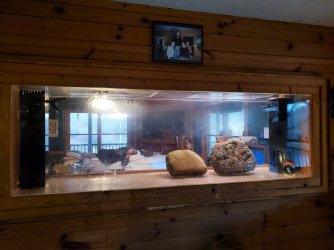"Pondholler" is actually the name of our farm as our house overlooks the aforementioned spring-fed, 3-acre pond and there are six other ponds on the place. I didn't think about the confusion here on this forum where folks actually set up and manage ponds, I was just trying to choose something that was easy to remember (I'm 73, lol). The 300 gallon tank is set in our living room wall and can also be seen from the master bedroom on the other side of the wall (in the attached pic, you can see through the empty tank where my husband is napping, lol). We spent all day yesterday cleaning out the tank with vinegar and a lot of elbow grease, so it is quite empty now. You wouldn't have wanted to see it before we cleaned it. The two pumps and the filter (blue balls, don't know what else they are called) and the plumbed-in faucet and drain are all under the tank and accessible from the bedroom side. I am thinking that our next step is to add the sand and landscaping rocks and driftwood, then fill and cycle the aquarium. Is this right? And at what point do we add plants, before or after cycling? Thanks for your attention, questions and good advice. So glad we found this forum!



